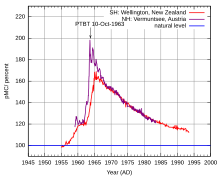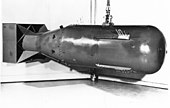
Back سقط نووي Arabic Radiasiya ekologiyası Azerbaijani Радыеактыўнае забруджванне Byelorussian Pluja radioactiva Catalan Alldafliad niwclear Welsh Radioaktivt nedfald Danish Radioaktiver Niederschlag German Lluvia radiactiva Spanish Euri erradioaktibo Basque بارش هستهای Persian

| Nuclear weapons |
|---|
 |
| Background |
| Nuclear-armed states |
|
| Part of a series on |
| Pollution |
|---|
 |
Nuclear fallout is residual radioactive material propelled into the upper atmosphere following a nuclear blast, so called because it "falls out" of the sky after the explosion and the shock wave has passed.[1] It commonly refers to the radioactive dust and ash created when a nuclear weapon explodes. The amount and spread of fallout is a product of the size of the weapon and the altitude at which it is detonated. Fallout may get entrained with the products of a pyrocumulus cloud and when combined with precipitation falls as black rain (rain darkened by soot and other particulates), which occurred within 30–40 minutes of the atomic bombings of Hiroshima and Nagasaki.[2] This radioactive dust, usually consisting of fission products mixed with bystanding atoms that are neutron-activated by exposure, is a form of radioactive contamination.
- ^ "Radioactive Fallout | Effects of Nuclear Weapons | atomicarchive.com". www.atomicarchive.com. Archived from the original on 18 January 2018. Retrieved 31 December 2016.
- ^ Energy & Radioactivity, Wikidata Q63214334